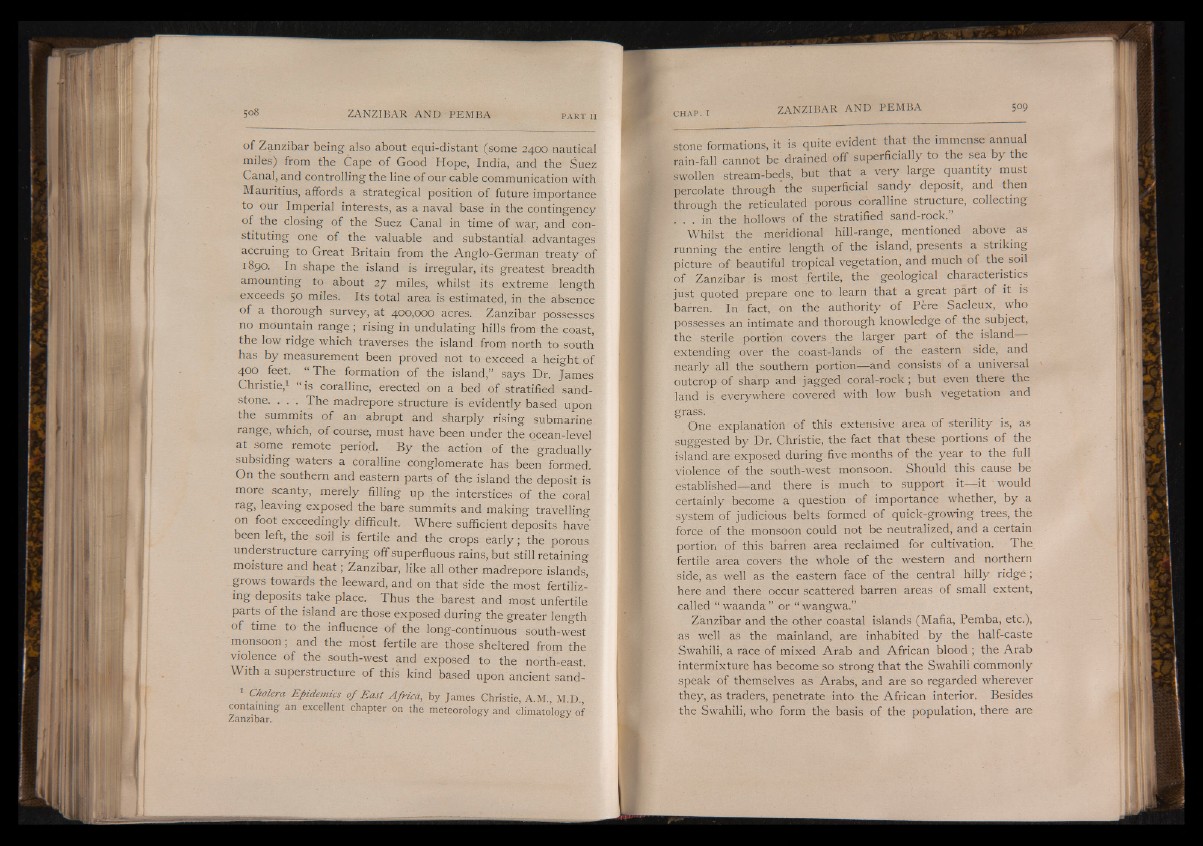
of Zanzibar being also about equi-distant (some 2400 nautical
miles) from the Cape of Good Hope, India, and the Suez
Canal, and controlling the line of our cable communication with
Mauritius, affords a strategical position of future importance
to our Imperial interests, as a naval base in the contingency
of the closing of the Suez Canal in time of war, and constituting
one o f the valuable and substantial advantages
accruing to Great Britain from the Anglo-German treaty of
1890. In shape the island is irregular, its greatest breadth
amounting to about 27 miles, whilst its extreme length
exceeds 50 miles. Its total area is estimated, in the absence
of a thorough survey, at 400,000 acres. Zanzibar possesses
no mountain range; rising in undulating hills from the coast,
the low ridge which traverses the island from north to south
has by measurement been proved not to exceed a height of
400 feet. “ The formation of the island,” says Dr. James
Christie,1 “ is coralline, erected on a bed of stratified sandstone.
. . . The madrepore structure is evidently based upon
the summits of an abrupt and sharply rising submarine
range, which, of course, must have been under the ocean-level
at some remote period. By the action of the gradually
subsiding waters a coralline conglomerate has been formed.
On the southern and eastern parts, o f the island the deposit is
more scanty, merely filling up the interstices of the coral
rag, leaving exposed the bare summits and making travelling
on foot exceedingly difficult. Where sufficient deposits have’
been left, the soil is fertile and the crops early; the porous
understructure carrying off superfluous rains, but still retaining
moisture and heat; Zanzibar, like all other madrepore islands,
__grows towards the leeward, and on that side the most fertilizing
deposits take place. Thus the barest and mqst unfertile
parts of the island are those exposed during the greater length
of time to the influence of the long-continuous south-west
monsoon; and the most fertile are those sheltered from the
violence of the south-west and exposed to the north-east.
With a superstructure of this kind based upon ancient sand-
1 Cholera Epidemics o f East Africa, by James Christie, A.M., M.D
containing an excellent chapter on the meteorology and climatology of
Zanzibar.
stone formations, it is quite evident that the immense annual
rain-fall cannot be drained off superficially to the sea by the
swollen stream-beds, but that a very large quantity must
percolate through the superficial sandy deposit, and then
through the reticulated porous coralline structure, collecting
. . . in the hollows of the stratified sand-rock.
Whilst the meridional hill-range, mentioned above ^ as
running the entire length of the island, presents a striking
picture of beautiful tropical vegetation, and much of the soil
of Zanzibar,is most fertile, the geological characteristics
just quoted prepare one to learn that a great part of it is
barren. In fact, on the authority of Pere Saeleux, who
possesses -an intimate and thorough knowledge of the subject,
the sterile portion covers the larger part of the island -
extending over the coast-lands of the eastern side, and
nearly all the southern portion— and consists of a universal
outcrop of sharp and jagged coral-rock; but even there the
land is everywhere covered with low bush vegetation and
grass.
One explanation of this extensive area of sterility is, as
suggested by Dr. Christie, the fact that these portions of the
island, are exposed during five months of the year to the full
violence of the south-west monsoon. Should this cause be
established— and there is much to support it— it would
certainly become a question of importance whether, by a
system of judicious belts formed of quick-growing trees, the
force of the monsoon could not be neutralized, and a certain
portion of this barren area reclaimed for cultivation. The,
fertile area covers the whole of the western and northern
side, as well as the eastern face of the central hilly ridge;
here and there occur scattered barren areas of small extent,
called “ waanda ” or “ wangwa.”
Zanzibar and the other coastal islands (Mafia, Pemba, etc.),
as well as the mainland, are inhabited by the half-caste
Swahili, a race of mixed Arab and African blood ; the Arab
intermixture has become so strong that the Swahili commonly
speak of themselves as Arabs, and are so regarded wherever
they, as traders, penetrate into the African interior. Besides
the Swahili, who form the basis of the population, there are